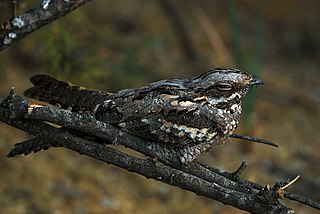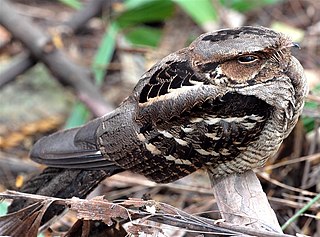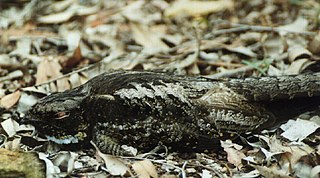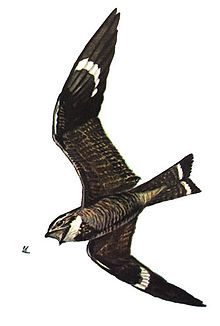
Nightjars are medium-sized nocturnal or crepuscular birds in the family Caprimulgidae and order Caprimulgiformes, characterised by long wings, short legs, and very short bills. They are sometimes called goatsuckers, due to the ancient folk tale that they sucked the milk from goats, or bugeaters, their primary source of food being insects. Some New World species are called nighthawks. The English word "nightjar" originally referred to the European nightjar.

The European nightjar, common goatsucker, Eurasian nightjar or just nightjar, is a crepuscular and nocturnal bird in the nightjar family that breeds across most of Europe and the Palearctic to Mongolia and Northwestern China. The Latin generic name refers to the old myth that the nocturnal nightjar suckled from goats, causing them to cease to give milk. The six subspecies differ clinally, the birds becoming smaller and paler towards the east of the range. All populations are migratory, wintering in sub-Saharan Africa. Their densely patterned grey and brown plumage makes individuals difficult to see in the daytime when they rest on the ground or perch motionless along a branch, although the male shows white patches in the wings and tail as he flies at night.

The common nighthawk or bullbat is a medium-sized crepuscular or nocturnal bird of the Americas within the nightjar (Caprimulgidae) family, whose presence and identity are best revealed by its vocalization. Typically dark, displaying cryptic colouration and intricate patterns, this bird is difficult to spot with the naked eye during the day. This bird is most conspicuous when in its buoyant and erratic flight. The most remarkable feature of this aerial insectivore is its small beak that belies the massiveness of its mouth. Some claim appearance similarities to owls. With its horizontal stance and short legs, the common nighthawk does not travel frequently on the ground, instead preferring to perch horizontally, parallel to branches, on posts, on the ground or on a roof. The males of this species may roost together but the bird is primarily solitary. The common nighthawk shows variability in territory size.

Jerdon's nightjar is a medium-sized nightjar species native to southern India and Sri Lanka. Formerly considered as a subspecies of the long-tailed nightjar, it is best recognized by its distinctive call which sounds like a wooden plank being beaten periodically with each note ending in a quaver. The common name commemorates Thomas C. Jerdon who described the species.

Caprimulgus is a large and very widespread genus of nightjars, medium-sized nocturnal birds with long pointed wings, short legs and short bills. Caprimulgus is derived from the Latin capra, "nanny goat", and mulgere, "to milk", referring to an old myth that nightjars suck milk from goats. The common name "nightjar", first recorded in 1630, refers to the nocturnal habits of the bird, the second part of the name deriving from the distinctive churring song.

The lesser nighthawk is a nightjar found throughout a large part of the Americas. This bird looks similar to the common nighthawk but is slightly smaller, has a slightly less deeply forked tail, and is more buffy in coloration. Their distinctive mouths are very well adapted for capturing insects mid-flight.

The eared nightjars are a small group of nocturnal birds in the nightjar family, although the taxonomy is uncertain. There are seven species, mainly found in forest and scrub from China to Australia. Five species are placed in the genus, Eurostopodus, the other two species in Lyncornis. They are long winged birds with plumage patterned with grey and brown to camouflage them when resting on the ground. They feed on insects caught in flight. A single white egg is laid directly on the ground and incubated by both adults. The chicks can walk soon after hatching.

The Caprimulginae or typical nightjars are a nocturnal bird subfamily within the nightjar family, Caprimulgidae. They are medium-size with long wings, short legs, and very short bills. They usually nest on the ground. They feed on flying insects.

Hawking is a feeding strategy in birds involving catching flying insects in the air. The term usually refers to a technique of sallying out from a perch to snatch an insect and then returning to the same or a different perch, though it also applies to birds that spend almost their entire lives on the wing. This technique is called "flycatching" and some birds known for it are several families of "flycatchers": Old World flycatchers, monarch flycatchers, and tyrant flycatchers; however, some species known as "flycatchers" use other foraging methods, such as the grey tit-flycatcher. Other birds, such as swifts, swallows, and nightjars, also take insects on the wing in continuous aerial feeding. The term "hawking" comes from the similarity of this behavior to the way hawks take prey in flight, although, whereas raptors may catch prey with their feet, hawking is the behavior of catching insects in the bill. Many birds have a combined strategy of both hawking insects and gleaning them from foliage.

The rufous-cheeked nightjar is a species of nightjar in the family Caprimulgidae. It is an intra-African migrant that breeds in the south of its range. It spends the non-breeding season in eastern Nigeria, Cameroon, southern Chad and Sudan, the Republic of the Congo, the D.R.C. and western Central African Republic. Throughout the year it can be found in Southern Africa. It is a nocturnal species that feeds on flying insects, mainly hunting at dusk and the early night. They can hunt at night thanks to their large eyes that are adept at seeing in the dark. They cannot see in complete darkness and most likely cannot see colours either. The rufous-cheeked nightjar forms monogamous pairs and the egg laying period is from September to November. It looks very similar to other African nightjars and they are frequently misidentified during research and studies.

The spotted nightjar or spotted eared-nightjar is a species of nightjar in the family Caprimulgidae. It inhabits much of mainland Australia and has also been found in several Indonesian islands. Its natural habitats are open forests and woodlands, scrub, spinifex and tussock grassland, savannah woodland and mangroves.

Antrostomus is a genus of nightjars formerly included in the genus Caprimulgus. They are medium-sized nocturnal birds with long pointed wings, short legs and short bills.















